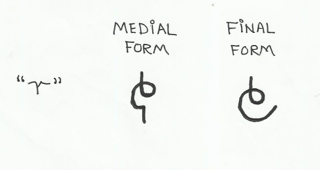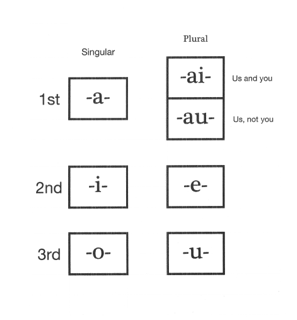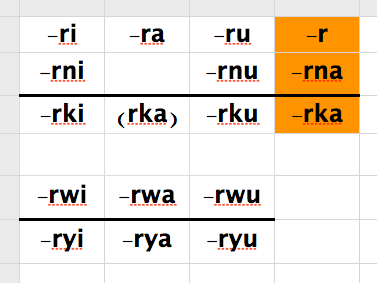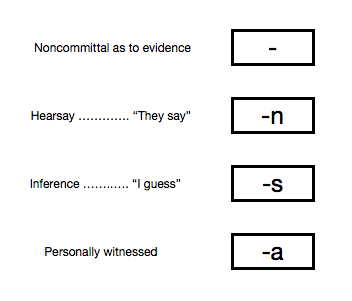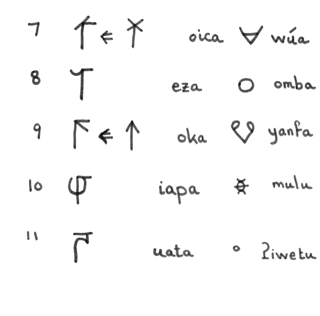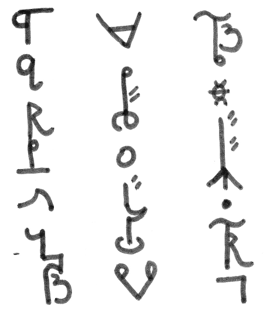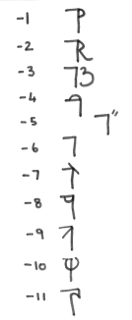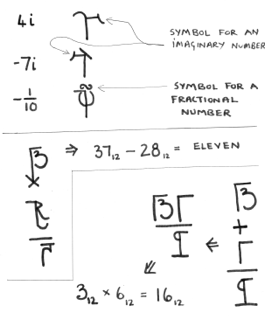Béu : Chapter 3: Difference between revisions
| Line 530: | Line 530: | ||
.. | .. | ||
==== . '''ʔà''' ... the gap clause particle==== | |||
.. | |||
This is basically the same as "what" in English, in such sentences as ... | |||
"WHAT you see is WHAT you get"<sup>*</sup> | |||
Notice that "you see" and "you get" are not complete clauses, there is a "gap" in them. | |||
The phase "WHAT you see", (to return to the mathematical analogy again) may be thought of as a "variable". in this case, the motivation for using a "variable", is to make the expression "general" rather than "specific". (Being general it is of course more worthy of our consideration). Other motivations for using a "variable" is that the actual argument is not known. Yet another is that even though the particular argument is known, it is really awkward to specify satisfactorily. | |||
EXAMPLE | |||
Another way to think about the '''ʔà''' construction, is to think of it as a "nominaliser", a particle that turns a whole clause into a noun. To use the example from just above .... | |||
"see" is an intransitive verb with to arguments. To replace one of these arguments by '''ʔà''' is like defining the missing argument in terms of the rest of the clause i.e. it changes a clause into a constuction that refers to one argument of that clause. | |||
<sup>*</sup>There is no generally agreed upon term for this type of construction. Dixon. | |||
PLURAL | |||
WITH THE PILANA | |||
WITH SPACE AND TIME | |||
.. | |||
==== . '''ʔà''' ... the gap clause particle==== | ==== . '''ʔà''' ... the gap clause particle==== | ||
Revision as of 05:42, 15 December 2013
..... The R-form of the verb
..
Now we should introduce the active forms of the verb (also referred to as the R-form). béu has quite a comprehensive set of tense/aspect markers. The active form of the verb is built up from the infinitive form. There is only one infinitive in béu.
We will discuss the most-used form of the verb in this section, the R-form. But first we should introduce a new letter.
..
..
This letter has not been mentioned so far because it doesn't occur in any words as such. It only occurs in the R-form of the verb.
So if you hear "r" or see the above symbol, you know you are hearing the main verb of a clause. (definition of a clause (semo) = that which has one "r" ... ??? )
O.K. ... the R-form is built up from the infinitive*.
1) First the final vowel is deleted.
*Excepts in rare cases (see "Adjectives and how they pervade other parts of speech")
..
... Slot 1
..
2) one of the 7 vowels below is added.
LINGUISTIC JARGON ... In the Western linguistic tradition, these markers are said to represent "person" and "number". Person is either first, second or third person (i.e. I, you, he or she). In the béu linguistic tradition they are called cenʔo-markers. (cenʔo = musterlist, people that you know, acquaintances, protagonist, list of characters in a play)
These markers represent the subject (the person that is performing the action). Whenever possible the pronoun that represents the subject is dropped, it is not needed because we have that information inside the verb with the cenʔo-markers.
Notice that there are 2 entries that represent the 1st person plural subject (i.e. we). The top one must be used when the people performing the action included the speaker, the spoken to and possibly others. The lower one must be used when the people performing the action include the speaker, NOT the person spoken to and one or more 3rd persons.
Note that the ai form is used where in English you would use "you" or "one" (if you were a bit posh) ... as in "YOU do it like this", "ONE must do ONE'S best, mustn't ONE".
LINGUISTIC JARGON ... This pronoun is often called the "impersonal pronoun" or the "indefinite pronoun".
So we have 7 different forms for person and number.
..
... Slot 2
..
3) now one of the 16 markers shown below is added. 16 is quite a respectable number, as far as tense/aspect markers go.*
Now these markers represent what are called tense/aspect markers in the Western linguistic tradition. In the béu linguistic tradition, they are called gwomai or "modifications". (gwoma = to alter, to modify, to adjust, to change one attribute of something).
The table above has the gwoma arranged according to form. The two arrays below have the gwoma arranged according to meaning. The items below the solid line are the negatives of the items above. An orange background indicates the timeless tense. You can see I have one entry enclosed by brackets. That is because to give a negative present tense negative you would express it periphrastically ... you would use the tenseless negative -rka followed by the béu equivalent of "now" or "at the moment".
Looking at the upper table, you can see the first 3 columns differ by their vowel. These are the tenses ... i for the past, a for the present and u for the future.
-ri ... This is the plain past tense. This is most often used when somebody is telling a story (a narrative). For example "Yesterday I got up, ate my breakfast and went to school". All three verbs in this narrative use the plain past tense.
-ra ... Should only be used if the action is happening NOW. English uses "to be xxxing". For example doikara = I am walking ... (doika = to walk)
-ru ... This is the future tense.
-r ... This has no time reference. It might be used for timeless "truths" such as "the sun rises in the West" or "birds fly".
The next row has what is called the habitual aspect. English has a past habitual (i.e. I used to go to school), Often in English the plain form of the verb is used as a habitual (i.e. I drink beer). Actually in béu the pattern is broken a bit, in that -rna has NOTHING to do with the activity going on at the time of speech, it is actually a tenseless habitual. Also béu and English behave the same in the following way ... whereas by logic we should use doikarna in "I walk (to school everyday)", in fact doikar is used. doikarna would be used only if we were going on to MENTION some exception (i.e. but last tuesday Allen gave me a lift)
doikarna = "sometimes I walk, and sometimes I choose not to walk" or even "I usually walk". If you walked on every occasion that was possible, then you would use doikar
-rnu ... Now English doesn't have a future habitual. But if it did it would have a roll. For instance, suppose you have just moved to a new house and are asked "how will you get to the supermarket". In béu you would answer doikarnu.
The next row expresses the perfect tense.
While the perfect tense, logically this doesn't have that much difference from the past tense it is emphasising a state rather than an action. It represents the state at the time of speaking as the outcome of past events. We have this tense/aspect in English and it is realized as "have xxxxen". For example if you wanted to talk to John and you went to his office, his secretary might say "he has gone to lunch" (as opposed to "he went for lunch"), which emphasises the absence of John. And think about the difference in meaning between "she has fallen in love" and "she fell in love" ... the first one means "she is in love" while the second one just talks about some of her history.
Another use for this tense is to show that something has happened at least once in the past. For example "I have been to London".
Easy to translate into English ... doikorwi = He/she had walked ... doikorwa = He/she has walked ... doikorwu = He/she will have walked
The next row expresses the "not yet" tense.
Easy to translate into English ... doikoryi = He/she had not yet walked ... doikorya = He/she hasn't walked yet ... doikoryu = He/she will not have walked
Notice that the English translation, doikoryu is just the negative of doikorwu. Interesting eh ? In fact these two aspects can be in many ways regarded as the negatives of each other, although in English only the future tense gives the surface forms this way.
Which leads us on to the next row. This row gives the negatives of row 1 and row 2 (that is right, row 2 does not have its own negative).
Just as -rna does not specify the present tense but instead gives a tenseless habitual, -rka gives a tenseless negative.
Easy to translate into English ... doikorki = He/she didn't walk ... doikorka = He/she doesn't walk ... doikorku = He/she will not walk
You may have noticed that the béu letter that negates verbs is very similar to the Chinese character that negates verbs (bù). This is pure coincidence.
By the way, the béu terms for the five aspects represented by these 5 rows are ... baga, dewe, pomo, fene, and liʒi.
*But even with 16 tense/aspect markers, not EVERY situation can be exactly expressed.
For example suppose two old friends from secondary school meet up again. One is a lot more muscular than before. He could explain his new muscles by saying "I have been working out" (using the progressive plus the perfect aspects). The "have" is appropriate because we are focusing on "state" rather than "action". The "am working out" is appropriate because it takes many instances of "working out" (or working out over some period of time) to build up muscles. béu has no tense/aspect marker so appropriate.
Every language has a limited range of ways to give nuances to an action, and language "A" might have to resort to a phrase to get a subtle idea across while language "B" has an obligatory little affix on the verb to economically express the exact same idea. You could swamp a language with affixes to exactly meet every little nuance you can think of (you would have an "everything but the kitchen sink" language). However in 99% of situations the nuances would not be needed and they would just be a nuisance.
By the way, in the above example, the muscular schoolmate would use the r form of the verb plus the béu equivalent of "now", to explain his present condition. Good enough.
..
... Slot 3
..
4) and finally one of the 4 teŋko-markers shown below is added.
teŋkai is a verb, meaning "to prove" or "to testify" or "to give evidence" or "to demonstrate" ... teŋko is a noun derived from the above, and means "proof" or "evidence".
About a quarter of the worlds languages have, what is called "evidentiality", expressed in the verb. As evidentials don't feature in any of the languages of Europe most people have never heard of them. In a language that has "evidentials" you can say (or you must say) on what evidence you are saying what you are saying. In béu there are 4 evidential suffixes. One is what is called a zero suffix. And in meaning it gives no information whatsoever as to what evidence the statement is based.
a) doikori = He/she walked ... this is neutral. The speaker has decided not to tell on what evidence he is saying what he is saying.
b) doikorin = They say he/she walked ... It this case the speaker is asserting "he walked" because somebody (or some people) have told him so.
c) doikoris = I guess he walked ... It this case the speaker is asserting "he walked" because he worked it out somehow.
The above 2 tenko are introducing some doubt, compared to the plain unadorned form (doikori). The fourth tenko on the contrary, introduced more certainty.
d) doikoria = I saw him walk ... In this case the speaked saw the action with his own eyes. This form can also be used if the speaker witnessed the action thru' another of his senses (maybe thru' hearing for example), but in the overwhelming majority of cases where this form is used, it means "I saw it myself".
This last teŋko can only be used with one of the gwomai . It can ONLY be used with the plain passed tense form i.
An o is used to connect word final '"r" to the evidential markers "n" and "s".
..
..... Some valency changing operations
... Valency ... 1 => 2
..
The following words are about internal feelings. They are all configured the same way in béu.
It is hard to say whether the active verb (the first column) or the infinitive (the second column) is the base form. I guess we can consider them equally fundamental.
The third column gives a transitive infinitive (derived from the column two entry by infixing a -y-).
The fourth column gives an adjective of the transitive verb (derived from column three entry by affixing a -ana ... the active participle).
| ʔoime | to be happy, happyness | ʔoimora | he is happy | ʔoimye | to make happy | ʔoimyana | pleasant |
| heuno | to be sad/sadness | heunora | she's sad | heunyo | to make sad | heunyana | depressing |
| taudu | to be annoyed | taudora | he is annoyed | tauju | to annoy | taujana | annoying |
| swú | to be scared, fear | swora | she is afraid | swuya | to scare | swuyana | frightening, scary |
| canti | to be angry, anger | cantora | he is angry | canci | to make angry | cancana | really annoying |
| yodi | to be horny, lust | yodora | she is horny | yoji | to make horny | yojana | sexy, hot |
| gái | to ache, pain | gayora | he hurts | gaya | to hurt (something) | gayana | painful * |
| gwibe | to be ashamed/shame/shyness | gwibora | she is ashamed/shy | gwibye | to embarrass | gwibyana | embarrassing |
| doimoi | to be anxious, anxiety | doimora | he is anxious | doimyoi | to cause anxiety, to make anxious | doimyana | worrying |
| ʔica | to be jealous, jealousy | ʔicora | she is jealous | ʔicaya | to make jealous | ʔicayana | causing jealousy |
..
The above shows is how to make an intransitive verb transitive.
It can be seen that it is normally formed by infixing -y-
When the final consonant is ʔ j c w or h the causative is formed by suffixing -ya
Also in short words, it is formed by suffixing -ya
Note ... when ya is added to a word ending in ai or oi, the final i is deleted.
Note ... when y is infixed behind t and d : ty => c and dy => j
Note ... All the verbs above are "state verbs". When state verbs are cited, the third person - present tense - no evidential form is used. Most verbs are "action verbs". When action verbs are cited, the third person - past tense - no evidential form is used. Also note that the infinitive of these state verbs, can in all cases be translated either as a noun or the noun form of an adjective.
Below is an example of this valency changing operation on an active verb.
doika = to walk
doikori = he walked
doikya = to run (as in "run a business")
doikyana = management
..
*You would describe a gallstone as gayana. However you would describe your leg as gaila (well provided you didn't have a chronic condition with your leg)
... Valency ... 2 => 1
..
The third and fourth columns show the passive forms.
The fifth column gives an adjective (derived from the column one entry by affixing a -wai ... the passive participle).
..
| kladau | to write | kladori | he wrote | kladwau | to be written | kladwori | It was written | kladwai | written |
| glói | to see | gloyori | she saw | gloiwa | to be seen | gloiwori | she was seen | gloiwai | seen |
| timpa | to hit | timpori | he hit | timpwa | to be hit | timpwori | he was hit | timpwai | hit |
| poʔau | to cook | poʔori | she cooked | poʔawa | to be cooked | poʔawori | it was cooked | poʔawai | cooked |
..
This is how to make a transitive verb passive. The subject of the active clause, can be included in the passive clause as an afterthought if required. It is added after the particle hí *
It can be seen that it is normally formed by infixing -w-
When the final consonant is ʔ y or h the passive is formed by suffixing -wa
Also in short words, it is formed by suffixing -wa
Note ... when wa is added to a word ending in au or eu, the final u is deleted.
Also note ... these operations can make consonant clusters which are not allowed in the base words. For example, in a root word -mpw- would not be allowed ( Chapter 1, Consonant clusters, Word medial)
..
*hí means "source" when it is not acting as a particle, introducing the agent in a passive clause.
..
... Concatenation of the valency changing derivations ... 1 => 2 => 1 and 2 => 1 => 2
..
| ʔoime | = to be happy | ʔoimye | = to make happy | ʔoimyewa | = "to be made to be happy" or, more simply "to be made happy |
..
| timpa | = to hit | timpawa | = to be hit | timpawaya | = to cause to be hit |
..
Semantically timpa is direct action (from agent to patient). Whereas timpawaya is indirect, possibly involving some third party between the agent and the patient and/or allowing some time to pass, between resolving on the action and the action being done unto the patient.
..
..... A discussion of English participles
..
Now English has two participles, the "active participle" and the "passive participle".
They appear as adjectives (of course, an adjective derived from a noun is the definition of "a participle"), however both forms also appear in verb phrases. If you are given a clause out of context it is sometimes impossible to tell if the participle is acting as an adjective or as part of a verb phrase. For example ... first the "active participle" ...
1) The writing man
2) The man is writing
3) The man is writing a book
In 1) "writing" is definitely an adjective. For instance you can substitute "green" for "writing" and the sentence makes perfect sense.
As for 2) ... well could be an adjective ... it passes the green-substitution-test.
For 3) ... No not an adjective "The man is green a book" doesn't make sense. The proper analysis of 3) is that "is writing" is a verb phrase (one that has given progressive meaning to the verb "write"). Now after we have figured this out we should have another look at 2). The proper analysis of this could be that "is writing" is a verb phrase. In fact there is no way to be sure and we would have to see the context in which 2) is embedded (and even then, there would be certain situations when either analysis could be valid. I would say that it is because of these situations in which either analysis is valid that let the original adjectival meaning spread and become a verbal meaning).
... now the "passive participle" ...
1) The broken piano
2) The piano is broken
3) The piano was broken
4) The piano was broken by the monkey
In 1) and 2) "broken" is definitely an adjective. For instance you can substitute "green" for "broken" and the sentence makes perfect sense.
As for 3) ... well could be an adjective ... it passes the green-substitution-test.
For 4) ... No not an adjective "The piano was green by the monkey" doesn't make sense. The proper analysis of 4) is that "was broken" is a verb phrase (one that has given passive meaning to the ambitransitive verb "break"). Now after we have figured this out we should have another look at 3). The proper analysis of this could be that "was broken" is a verb phrase. In fact there is no way to be sure and we would have to see the context in which 3) is embedded (and even then, there would be certain situations* when either analysis could be valid. I would say that it is because of these situations in which either analysis is valid that let the original adjectival meaning spread and become a verbal meaning).
*The five-week deadlock between striking Peugeot workers and their employer was broken yesterday when the management obtained a court order to end a 10-day sit-in at one of the two factories in eastern France, Sarah Lambert writes.
I would say either analysis is valid for the above sentence.
..
..... The béu participles
..
There are four participles in béu. They are known as plovai in the béu linguistic tradition.
A participle is an adjective that has been derived from a verb.
..
... the habitual participle
..
The habitual participle is formed by affixing -ana to the infinitive. For example ...
kludau = to write
kludana = habitually writing
and because of the strong tendency of adjectives to also serve as nouns ...
kludana = the one who is always writing => writer/author
..
... the passive participle
..
The passive participle is formed by affixing -wai to the infinitive. For example ...
kludau = to write
kludwai = written
and because of the strong tendency of adjectives to also serve as nouns ...
kludwai = the one that is written => a note
..
... the present participle
..
The present participle is formed by affixing -la to the infinitive. For example ...
kludau = to write
kludaula = writing at this moment => the one writing at this moment
..
... the future participle
..
The plain infinitive can be used to modify a noun
toili = book
toili kludau = the book that must be written
Notice that the meaning is "the book that SHOULD be written" rather than "the book that WILL be written"
Maybe the name "future participle" is not ideal ... never the less, it is called the future participle.
and because of the strong tendency of adjectives to also serve as nouns ...
kludau = that which must be written => an (school) assignment
..
... Parenthesis
..
béu has two particles that indicate the start of some sort of parenthesis. In a similar way to a mathematical formula, where brackets mean that the arguments within the brackets should be evaluated first, the two béu particles indicate that the immediately following clause should be processed (by the brain) before arguments outside of the parenthesis are considered.
..
. hà ... the full clause particle
..
This is basically the same as "that" in English, when "that" introduces a complement clause. For example ...
"He said THAT he was not feeling well"
Notice that "he was not feeling well" is complete in itself, it is a self-contained clause.
..
. ʔà ... the gap clause particle
..
This is basically the same as "what" in English, in such sentences as ...
"WHAT you see is WHAT you get"*
Notice that "you see" and "you get" are not complete clauses, there is a "gap" in them.
The phase "WHAT you see", (to return to the mathematical analogy again) may be thought of as a "variable". in this case, the motivation for using a "variable", is to make the expression "general" rather than "specific". (Being general it is of course more worthy of our consideration). Other motivations for using a "variable" is that the actual argument is not known. Yet another is that even though the particular argument is known, it is really awkward to specify satisfactorily.
EXAMPLE
Another way to think about the ʔà construction, is to think of it as a "nominaliser", a particle that turns a whole clause into a noun. To use the example from just above ....
"see" is an intransitive verb with to arguments. To replace one of these arguments by ʔà is like defining the missing argument in terms of the rest of the clause i.e. it changes a clause into a constuction that refers to one argument of that clause.
*There is no generally agreed upon term for this type of construction. Dixon.
PLURAL
WITH THE PILANA
WITH SPACE AND TIME
..
. ʔà ... the gap clause particle
..
This is basically the same as "what" in English, in such sentences as ...
"WHAT you see is WHAT you get"*
Notice that "you see" and "you get" are not complete clauses, there is a "gap" in them.
The phase "WHAT you see", (to return to the mathematical analogy again) may be thought of as a "variable". in this case, the motivation for using a "variable", is to make the expression "general" rather than "specific". (Being general it is of course more worthy of our consideration). Other motivations for using a "variable" is that the actual argument is not known. Yet another is that even though the particular argument is known, it is really awkward to specify satisfactorily.
EXAMPLE
Another way to think about the ʔà construction, is to think of it as a "nominaliser", a particle that turns a whole clause into a noun. To use the example from just above ....
"see" is an intransitive verb with to arguments. To replace one of these arguments by ʔà is like defining the missing argument in terms of the rest of the clause i.e. it changes a clause into a constuction that refers to one argument of that clause.
*There is no generally agreed upon term for this type of construction. Dixon.
PLURAL
WITH THE PILANA
WITH SPACE AND TIME
..
... the NP with the present participle core ??
..
Now the phrase jono kludala toili is a noun phrase (NP) in which the adjective phrase (AP) qualifies the noun jono
(Notice that in the clause that corresponds to the above NP, jonos kludora toili (John is writing the book), jono has the ergative suffix and the 3 words can occur in any order : with the NP, jono does not take the ergative suffix and the 3 words must occur in the order shown.)
glói = to see
polo = Paul
timpa = to hit
jene = Jenny
glori polo timpala é = He saw paul hitting something
glori pá timpala ó = He saw me hitting her
glori jene timpwa = He saw Jenny being hit
glori polo timpala jene = He saw Paul hitting Jenny
glori pà timpala jene = He saw me hitting Jenny.
Now the question is where is this special NP used. Well it is used in situations where English would use a complement clause. For example with algo meaning "to think about",*
1) algara jono = I am thinking about John.
2) algara jono kludala toili = I am thinking about John writing a book.
Note ... According to Dixon, the standard English translation of 2) would be "I am thinking about John's writing a book" which I find quite strange even though English is my mother tongue. I have decided to call this sort of construction in béu a special kind of NP, while Dixon has called the equivalent expression in English the "-ing" type of complement clause. I think this is just a naming thing and doesn't really matter.
*"to think (that)" is alhu in béu. alhu also translates "to believe".
..
... Simple arithmetic
noiga = arithmetic
Above right you can see the numbers 1 -> 11 displayed. Notice that the forms of 1, 3, 6, 7 and 9 have been modified slightly before the "number bar" has been added.
In the bottom right you can see 7 interesting symbols. These are used to extend the range of the béu number system (remember the basic system only covers 1-> 1727). Their meanings are given in the table below.
| elephant | huŋgu |
| rhino | nàin |
| water buffalo | wúa |
| circle | omba |
| hare | yanfa |
| beetle | mulu |
| bacterium, bug | ʔiwetu |
To give you an idea of how they are used, I have given you a very big number below.
Which is => 1,206,8E3,051.58T,630,559,62 ... E represents eleven and T represents ten ... remember the number is in base 12.
O.K. this number has a ridiculous dynamic range. But this is for demonstration purposes only: if you can handle this number you can handle any number.
This monster would be pronounced aja huŋgu ufaila nàin ezaitauba wúa idauja omba idaizaupa yanfa elaibau mulu idaidauka ʔiwetu elaifau dó
Now the 7 "placeholders" are not really thought of as real numbers, they are markers only. Used in the same way that we would say "point"/"decimal" when reeling off a number.
When first introduced to this system, many people think that the béu culture must be untenable, however strangely enough the béu culture has lasted many thousands of year, despite the obvious confusion that must arise when they attempt to count elephants.
One further point of note ...
If you wanted to express a number represented by digits 2->4 from the LHS of the monster, you would say aufaidaula nàin .... the same way as we have in the Western European tradition. However if you wanted to express a number represented digits 6 ->8 from the RHS of the monster, you would say yanfa elaibau .... not the way we do it. This is like saying "milli 630" instead of "630 micro".
To make a number negative the "number bar" is placed on the left. See below ;-
Also a number can be made imaginary by adding a further stroke that touches the "number bar". See below ;-
As you can see above, there is no special sign for the "addition operation". The numbers are simply written one beneath the other. Similarly with subtraction but one number would be negative this time.
There is a special sign to indicate multiplication (+), and there is an equals sign (-).
Division is the same as multiplication except that one of the numbers is in "fractional form".
There is an alternative multiplication/division notation : instead of using the + sign, the two quantities can instead be written side by side (see the example above).
-6 is pronounced ela liʒi ... liʒi means left or "negative
By the way lugu means right (as in right-hand-side) or positive.
4i is pronounced uga haspia ... and what does haspia mean, well it is the name of the little squiggle that touches the number bar, for one thing.
-4i is pronounced uga haspia liʒi
-1/10 is pronounced diapa liʒi
i/4 is pronounced duga haspia
And so ends chapter 2 ...
... Index
- Introduction to Béu
- Béu : Chapter 1 : The Sounds
- Béu : Chapter 2 : The Noun
- Béu : Chapter 3 : The Verb
- Béu : Chapter 4 : Adjective
- Béu : Chapter 5 : Questions
- Béu : Chapter 6 : Derivations
- Béu : Chapter 7 : Way of Life 1
- Béu : Chapter 8 : Way of life 2
- Béu : Chapter 9 : Word Building
- Béu : Chapter 10 : Gerund Phrase
- Béu : Discarded Stuff
- A statistical explanation for the counter-factual/past-tense conflation in conditional sentences
